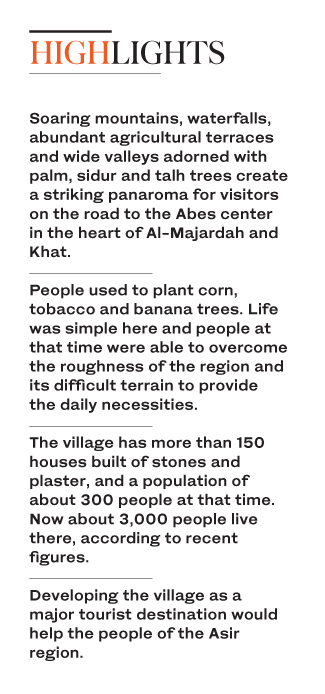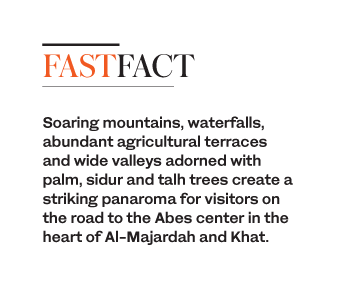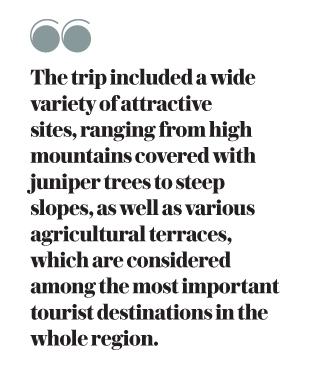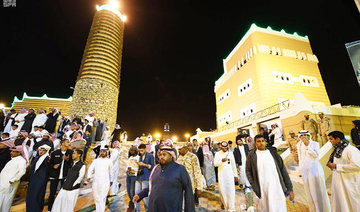JEDDAH: To an outsider, the mountains surrounding the center of Khat, in Al-Majardah province in northwestern Asir, appear impassable — but for the gifted people who settled there, the peaks provided a sanctuary for their historic “hanging villages.” Now a new tourist window is opening on the region’s hanging villages, about 180km from Abha, which are among the most striking sights in Saudi Arabia. While touring the region, SPA found that history comes to life on a journey of discovery in the villages.
Departing from the city of Abha on a tourist road to Taif, and passing through the provinces of Tanomag and Al-Namas, SPA visited the village of Al-Khadra, in the north of Al-Namas Province. The trip included a wide variety of attractive sites, ranging from high mountains covered with juniper trees to steep slopes, as well as various agricultural terraces, which are considered among the most important tourist destinations in the whole region.
Soaring mountains, waterfalls, abundant agricultural terraces and wide valleys adorned with palm, sidur and talh trees create a striking panaroma for visitors on the road to the Abes center in the heart of Al-Majardah and Khat. There, a number of residents were waiting to act as guides to the hanging villages.
The residents highlighted the need for a four-wheel-drive vehicle to reach the village of Al-Sumayd. Vehicles were provided by Abdul Rahman Mohammed Al-Sumaydi, a Khat resident who described the center’s history and explained the network of old roads used to access it. Al-Sumaydi is looking forward to paving the road leading to the village to protect it from flooding. He explained the  development of the region to encourage tourism.
development of the region to encourage tourism.
The road crosses from the Al-Hussein area through the Qaa’, then passes through Mizher Mountain and the villages of the Al-Muhammad tribes of Bani Amr and ends in the village of Rahwat Al-Sumayd, which lies on the summit of the Khat mountains, more than 1,500 meters above sea level.
Al-Sumaydi said the ancient village included mountain-top palaces and castles that house archaeological artefacts and rock inscriptions. Agricultural terraces around the village offered a living for people at the time.
“The village was characterized by the basins dug in the core of the black rock, which vary in length, width and depth,” he said. “They are the main source of potable water for the people of the village, by filling the tanks dug in the ground with rainwater. That water was also used for irrigation of agricultural terraces and for watering livestock.”
Mohammed bin Ali bin Dahman Al-Shahri, 70, shared memories of his childhood growing up in the hanging village.
“I spent two decades in this place amid the houses built with stones, mud and wood, surrounded by farms that were the source of our livelihood at the time. People used to plant corn, tobacco and banana trees. Life was simple here and people at that time were able to overcome the roughness of the region and its difficult terrain to provide the daily necessities,” he said.
The village has more than 150 houses built of stones and plaster, and a population of about 300 people at that time. No w about 3,000 people live there, according to recent figures. “The village’s isolation and limited access forced residents to travel to nearby centers and neighboring provinces for essential services,” he said.
w about 3,000 people live there, according to recent figures. “The village’s isolation and limited access forced residents to travel to nearby centers and neighboring provinces for essential services,” he said.
Al-Shahri said he hoped the village would receive help to create public services such as roads.
Developing the village as a major tourist destination would help the people of the Asir region, in particular, and the Kingdom in general, he said.
The ‘hanging villages’ atop Assiri mountains bare marks of early civilization
The ‘hanging villages’ atop Assiri mountains bare marks of early civilization

- The region opens a new window for visitors seeking tourism in this area, given its attractive nature, between high mountain lands, covered in Juniper trees
- Developing the village as a major tourist destination would help the people of the Asir region
























